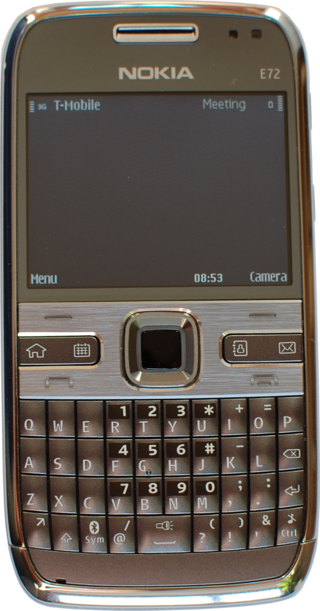Top Qs
Timeline
Chat
Perspective
Nokia E72
Cell phone model From Wikipedia, the free encyclopedia
Remove ads
The Nokia E72 is a smartphone that was marketed as part of Nokia's Eseries range of business-oriented products. The Nokia E72 was announced on June 15, 2009 at the Nokia Connections 2009 event in Singapore.[2] It is the successor to the Nokia E71 and is based on a similar design and form factor, and offers a similar feature set. It has standard features including mobile email, calendar and instant messaging among many others with its Symbian-based S60 3rd Edition Feature Pack 2 operating system. The E72 was manufactured in Finland. It was succeeded by Nokia E6 in 2011.
The Nokia E72 has a new Optical Navi Key feature in addition to the standard D-pad used on many other Nokia devices including the Nokia E71 – this is said to improve the ease of scrolling through menus, emails, web pages, and images as it is an optical sensor in addition to a series of closely spaced buttons. In comparison to its predecessor, the Nokia E72 is said to have a higher level of performance (likely due to the faster 600 MHz ARM processor) and also includes a 5-megapixel auto focusing camera. Other changes and improvements are software-based including changes to the user interface and built-in messaging application among others.
Remove ads
Firmware
The current firmware of this device is 91.004 published on 2 June 2012 (to check the current firmware, one may dial *#0000#).
Variants
The Nokia E73 Mode is a USA feature phone for T-Mobile USA, with support for T-Mobile's UMA service and Band IV support for 3G. It is a different piece of hardware internally from the E72.
A Chinese domestic market variant is Nokia E72i, lacking WiFi connection.
The Vertu Constellation Quest from 2010 is based on the E72 design.
Features and enhancements from E71
- 5-megapixel camera, lithium-ion battery and stainless steel cover of the Nokia E72
- Back
- Black E72
New features
- Symbian OS 9.3, Series 60 v3.2 UI, Feature Pack 2.
- Optical navi key, along with the conventional D-Pad
- 3.5 mm audio jack
- Ovi Maps with free lifetime drive and walk voice assisted navigation
- Lifetime free Nokia Messaging service (discontinued)
- Use of front-facing camera (video call, VGA, QVGA snapshots and QCIF videos for 15 seconds)
- USB charging
- Magnetometer sensor and digital compass
- RDS support
- PictBridge
- uPnP media streaming support (not present on E73)
- UMA (E73)
Improvements
- Modified design and look compared to E71.
- 3.5 mm jack in contrast to the 2.5 mm jack used in the E71.
- 12 hours of talktime (2G) instead of the E71's 10 hours (2G).
- Tri-band UMTS/HSDPA/HSUPA instead of dual-band
- HSDPA support of up to 10.2 Mbit/s instead of 3.6
- Added HSUPA at 2.0 Mbit/s
- Improved CPU clock speed from 369 MHz to 600 MHz
- Real time Push e-mail HTML
- Improved reception from the E71's fluctuating signal reception
- 5-megapixel camera (up from 3.2)
- VGA 640x480 at 15 frames per second (E72) rather than QVGA 320x240 at 15 frames per second (E71)
- New flashlight feature (it can be activated by holding down the space bar)
See also
- Nokia Eseries
- Nokia E5-00 Reduced-cost version of the E72
- Nokia N72
- Nokia E73 Mode
References
Further reading
External links
Wikiwand - on
Seamless Wikipedia browsing. On steroids.
Remove ads




